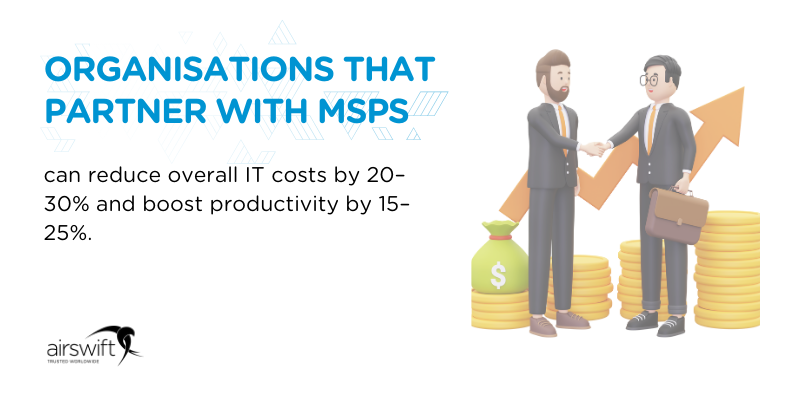
By
Diyaa Mani
April 24, 2025
Updated
September 30, 2025
What are MSPs?
From managing a growing contingent workforce to staying compliant with evolving labour laws, businesses are under pressure to scale quickly—without slipping up.
That’s where modern Managed Service Providers (MSPs) come in.
Once focused mainly on admin-heavy tasks like vendor management and cost control, today’s MSPs offer so much more. They’ve become strategic partners—leveraging data, tech, and market expertise to help businesses solve workforce challenges, scale smarter, and make more informed hiring decisions.
If you're struggling to keep up with workforce demands or unsure how to future-proof your talent strategy, it might be time to rethink what an MSP can do for you.
Benefits of working with an MSP
Partnering with a Managed Service Provider (MSP) offers numerous advantages that can significantly enhance a business's operational efficiency, scalability, and bottom line. Here’s a detailed look at the key benefits:
Expertise and specialised knowledge
Working with an MSP provides access to a team of professionals with diverse experience across various industries. This expertise is invaluable for tackling challenges that go beyond the capabilities of an in-house team.
Moreover, outsourcing to an MSP is a cost-effective alternative to building in-house expertise, often requiring significant training and recruitment investment. By leveraging the MSP’s specialised knowledge, businesses can address specific needs without the long-term commitment of hiring full-time staff.
Scalability and flexibility
One of the most significant advantages of partnering with an MSP is scaling services up or down based on business needs. This flexibility allows companies to adapt quickly to changing market conditions, seasonal fluctuations, or unexpected growth opportunities.
Additionally, MSPs typically offer predictable pricing models that align with business growth, clearly understand costs, and help manage budgets more effectively. This ensures that resources are optimally utilised, reducing waste and enhancing operational agility.
Enhanced efficiency

By continuously monitoring systems and processes, MSPs can identify and resolve potential issues —such as outdated technology, lack of automation, inconsistent agency engagement, poorly managed site access, unclear market rates, and unaddressed liability risks— before they become significant problems.
For example, an MSP can spot when outdated systems are slowing down hiring processes, detect when too many agencies are being used without a clear management process, or flag when there is insufficient visibility over who is on-site and what access they have. If left unchecked, these could lead to inefficiencies or increased risks.
This hands-on approach is backed by clear processes, solid documentation, and smart technology that keeps everything running smoothly. It helps reduce disruptions, boost productivity, and allows businesses to stay focused on what they do best, without sacrificing efficiency.
Cost savings
Outsourcing to an MSP can lead to significant cost savings. By leveraging the MSP’s existing infrastructure and expertise, businesses can reduce operational costs associated with managing contingent workforces or other specialised services such as temporary staffing, supplier coordination, and workforce compliance.
Instead of handling multiple vendors and complex billing rates internally, an MSP centralises these functions, streamlining processes and eliminating inefficiencies that often result from disjointed management.
Additionally, partnering with an MSP avoids capital investments in technology or hiring full-time staff, which can be costly and may not always align with fluctuating business needs. This cost-effectiveness allows companies to allocate resources strategically, focusing on growth initiatives and innovation.
Access to advanced technology
MSPs typically have access to the latest tools, software, and analytics platforms, which can be expensive for individual businesses to acquire and maintain. By partnering with an MSP, companies can immediately benefit from these advanced technologies without the upfront costs or ongoing maintenance responsibilities.
With this access, businesses can tap into data-driven insights that sharpen decision-making and keep them competitive. Plus, MSPS bring the know-how to weave these technologies into existing systems seamlessly, keeping things running smoothly and helping companies get the most out of their investment.
Challenges of working with an MSP
While Managed Service Providers (MSPs) offer numerous benefits, businesses should consider potential drawbacks to make informed decisions. Below are several challenges associated with partnering with an MSP, along with suggestions on how to overcome them:
Delegating control
One significant drawback of working with an MSP is relinquishing control over certain operational aspects.
When outsourcing workforce management or other services, businesses may find that their internal processes or preferences are not fully aligned with the MSP's approach. This misalignment can lead to inefficiencies or frustration, especially if the MSP’s levels of service differ from the company’s established workflows.
Additionally, some organisations may feel disconnected from critical decision-making processes, impacting overall satisfaction.
To mitigate this issue, businesses should:
- Clearly define expectations: Ensure service level agreements (SLAs) and contracts explicitly outline responsibilities and processes to align with internal practices and agreed-upon service levels.
- Regular communication: Schedule regular check-ins with the MSP to address discrepancies and ensure ongoing alignment with business objectives.
- Hybrid models: Consider hybrid models where some control is retained internally while leveraging the MSP for specific tasks.
Long-term commitments
While MSP partnerships are designed to be agile and adaptable, entering into a long-term agreement still requires careful consideration. Some businesses may worry about becoming too dependent on a single provider, especially if the MSP uses specific platforms, processes, or tools.
If expectations aren’t met, transitioning to a new provider can take time and effort. However, with the right setup and planning, organisations can maintain flexibility throughout the partnership.
To avoid, keep options open:
- Use open standards: Insist on using open standards and interoperable systems to ensure compatibility with other providers.
- Clearly define exit clauses: Negotiate clear exit clauses in contracts that outline data portability and transition processes.
- Plan for flexibility with multi-vendor strategies: Consider maintaining relationships with multiple providers to reduce dependency on a single MSP.
Quality variability
While every business wants high-quality service and talent, not all MSPs are created equal. Some may fall short due to stretched resources, weak vendor networks, or a lack of industry-specific knowledge.
This underscores the importance of conducting thorough research and due diligence before selecting an MSP — one that doesn’t just fill roles but improves talent quality through strong relationships with staffing suppliers, direct talent networks, and proven sourcing strategies.
To ensure consistent quality:
- Evaluate their track record: Conduct extensive research on potential MSPs, including reviews, case studies, and client testimonials.
- Set clear expectations: Establish clear service level agreements (SLAs) with measurable performance metrics to ensure accountability.
- Regular performance reviews: Schedule regular reviews to assess the MSP’s performance, identify improvement areas and ensure continued alignment.
Limited business-specific knowledge

MSPs that spread themselves too thin across multiple industries often lack the depth needed to navigate the complexity of specialised sectors like STEM. Generic, one-size-fits-all models can miss the mark when it comes to understanding vendor-specific nuances, compliance requirements, and the highly skilled talent your industry demands.
To overcome this limitation:
- Prioritise industry experience: Choose a provider with proven results in your sector and a network that reflects your niche talent needs.
- Collaborative approach: Foster an environment where the MSP works closely with internal teams to better understand specific business needs.
- Customised solutions: Request solutions tailored to the organisation’s unique requirements.
Cost concerns vs long-term savings
Cost is often one of the first concerns raised when evaluating an MSP partnership, especially when premium services or complex programmes are involved. Upfront fees or recurring costs may seem high at first glance, particularly for smaller organisations or those with tight budgets.
However, when implemented effectively, MSPs can unlock significant long-term savings. By streamlining processes, consolidating vendor management, and reducing time-to-hire, MSPs help businesses avoid hidden costs related to inefficiencies, turnover, and poor hiring decisions.
To manage cost concerns effectively:
- Conduct a cost-benefit analysis: This ensures that the MSP’s services align with budget constraints and deliver tangible benefits.
- Negotiate scalable pricing models: Negotiate flexible MSP pricing models that scale with business growth or needs.
- Review cost performance regularly: Schedule regular reviews to track ROI, address inefficiencies and adjust scope or pricing if needed.
How to choose the right MSP

Choosing the right Managed Service Provider (MSP) requires a thoughtful and structured approach.
- First, define your business needs by identifying areas where an MSP can add value, such as contingent workforce management or talent engagement.
- Next, evaluate providers thoroughly by assessing their expertise, scalability, pricing models, and client testimonials to ensure they align with your goals.
- Finally, ask key questions during the evaluation process to ensure alignment on critical aspects such as strategic goals, tools and technologies, response times, and confidentiality practices.
By following these steps, businesses can select an MSP that meets immediate needs and serves as a strategic partner for long-term success.
Leveraging MSPs for long-term success
Modern MSPs have evolved from service providers to strategic partners, providing more than just operational support.
To maximise the benefits of working with an MSP, businesses should conduct thorough evaluations, focusing on expertise, scalability, and alignment with their unique needs. Choosing the right MSP can be a transformative step toward achieving business efficiency and sustained growth.
Ready to take your workforce management to the next level? Partner with Airswift’s MSP services today and experience customised solutions to empower your business.

